

Introduction to Computational Media Video Series. Codes - GENERATIVE GESTALTUNG. P_1_0_01. Codes - GENERATIVE GESTALTUNG. Cell Cycle - WebGL design app - create organic designs for 3d printing.
About - GENERATIVE GESTALTUNG. Processing Hour of Code. The Nature of Code. Hello!
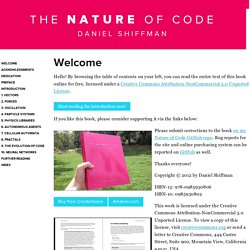
By browsing the table of contents on your left, you can read the entire text of this book online for free, licensed under a Creative Commons Attribution-NonCommercial 3.0 Unported License. Start reading the introduction now! If you like this book, please consider supporting it via the links below: Please submit corrections to the book on my Nature of Code GitHub repo. Bug reports for the site and online purchasing system can be reported on GitHub as well. Thanks everyone! Copyright © 2012 by Daniel Shiffman This work is licensed under the Creative Commons Attribution-NonCommercial 3.0 Unported License. Processing Library – Traer Physics. Processing. DXF \ Libraries. DXF Export The DXF library writes all triangle-based graphics (polygons, boxes, spheres, etc.) to a DXF file.

It works with the beginRaw() and endRaw() functions. These functions will grab and save the shape data just before it is rendered to the screen. At this stage, your entire scene is nothing but a long list of lines and triangles. This means that a shape created with the sphere() function will be made up of hundreds of triangles, rather than a single object. Processing Library – DXF Export. Processing Library – DXF Export Posted by iainmaxwell on Saturday, October 2, 2010 · Leave a Comment Processing Library – DXF Export The simplest way to get vector-based graphics out of Processing is to use the DXF library that comes pre-installed with Processing.
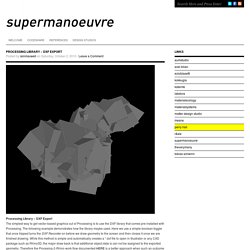
The following example demonstrates how the library maybe used. Here we use a simple boolean toggle that once tripped turns the DXF Recorder on before we draw geometry to the screen and then closes it once we are finished drawing. While this method is simple and automatically creates a *.dxf file to open in Illustrator or any CAD package such as Rhino3D, the major draw back is that additional object data is can not be assigned to the exported geometry. DXF \ Libraries. DXF Export The DXF library writes all triangle-based graphics (polygons, boxes, spheres, etc.) to a DXF file.
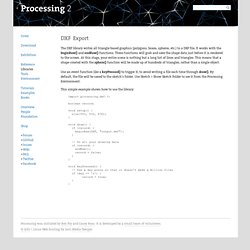
It works with the beginRaw() and endRaw() functions. These functions will grab and save the shape data just before it is rendered to the screen. At this stage, your entire scene is nothing but a long list of lines and triangles. This means that a shape created with the sphere() function will be made up of hundreds of triangles, rather than a single object. Use an event function like a keyPressed() to trigger it, to avoid writing a file each time through draw(). This simple example shows how to use the library: import processing.dxf.*; boolean record; void setup() { size(500, 500, P3D); } void draw() { if (record) { beginRaw(DXF, "output.dxf"); } // Do all your drawing here if (record) { endRaw(); record = false; } } void keyPressed() { // Use a key press so that it doesn't make a million files if (key == 'r') { record = true; } }
Libraries. Tutorials: Libraries. Contributed Libraries This tutorial is an updated version of Section 12.3: Contributed Libraries.

Processing now allows for a “libraries” folder inside your Processing sketchbook, which is a great deal more convenient than having your 3rd party libraries installed in the Processing application folder. Now, when you upgrade to a new version of Processing you don’t have to copy your libraries over. As of the writing of this book, there are 47 contributed libraries, with capabilities ranging from sound generation and analysis, to packet sniffing, to physics simulations, to GUI controls. Amnon P5 - Experiments with Processing by Amnon Owed. Working with Toxiclibs Posted by Amnon on April 23, 2011 · 7 Comments Hey everyone!
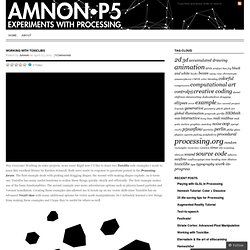
Working on some projects, more soon! Working with #Toxiclibs - #Processing tutorial by Amnon Owed. Casey Reas. GroupC.net / REAS. Plethora Library [plibs] in Processing – Plethora Project. Processing Tutorials – Plethora Project. Plethora-Project.com is an initiative to accelerate computational literacy in the frame of architecture and design.

It aligns with the "show me your screens" motto of the TopLap live-coding group attempting to get rid of Obscurantism in digital design. Directed by Jose Sanchez Contact me at : jomasan@gmail.com Bio: Jose Sanchez is an Architect / Programmer / Game Designer based in Los Angeles, California. He is partner at Bloom Games, start-up built upon the BLOOM project, winner of the WONDER SERIES hosted by the City of London for the London 2012 Olympics. He is the director of the Plethora Project (www.plethora-project.com), a research and learning project investing in the future of on-line open-source knowledge.
SurfaceLib. Learning Processing: A Beginner's Guide to Programming Images, Animation, and Interaction by Daniel Shiffman. The Nature of Code. “A library implies an act of faith/Which generations still in darkness hid/Sign in their night in witness of the dawn.” — Victor Hugo Before we move on to anything else, let’s revisit some of the things we’ve done in the first four chapters.
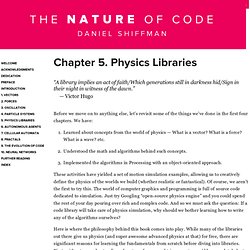
We have: The Nature of Code. “Don’t underestimate the Force.” — Darth Vader In the final example of Chapter 1, we saw how we could calculate a dynamic acceleration based on a vector pointing from a circle on the screen to the mouse location.

The resulting motion resembled a magnetic attraction between circle and mouse, as if some force were pulling the circle in towards the mouse. In this chapter we will formalize our understanding of the concept of a force and its relationship to acceleration. Our goal, by the end of this chapter, is to understand how to make multiple objects move around the screen and respond to a variety of environmental forces. Physics- Collections at OpenProcessing. Physics- Collections at OpenProcessing. Processing GUI, controlP5. About controlP5 is a library written by Andreas Schlegel for the programming environment processing.

Last update, 07/30/2015. Controllers to build a graphical user interface on top of your processing sketch include Sliders, Buttons, Toggles, Knobs, Textfields, RadioButtons, Checkboxes amongst others and can be easily added to a processing sketch. They can be arranged in separate control PGraphics contexts, and can be organized in tabs or groups. → read more. Installation Unzip and put the extracted controlP5 folder into the libraries folder of your processing sketches. Details Keywords gui, ui, controller, interface, user interface Reference. Source. Platform osx, windows, linux Processing 2.2.1 Dependencies none User interface for the 'vulcano generator'. project synthazards, syntfarm. Processing GUI, controlP5. Processing Tutorials – Plethora Project. Processing / Eclipse – Plethora Project.
Processing / Eclipse – Plethora Project. Processing Tutorials – Plethora Project. Plethora Library [plibs] in Processing – Plethora Project. The Hour of Code 2013. Tutorials. Import processing.opengl.*; import igeo.*; size( 480, 360, IG.GL ); After having "import" lines for the libraries, the first line to write is "size" method. The first number of the input arguments specifies window width and the second one does window height. The third one IG.GL tells processing to use iGeo and this instantiates iGeo system in the background. Language Reference (API) \ Processing 2+ Processing. Processing / Eclipse – Plethora Project. Dynamic Behaviors. Introduction to Processing. Takeaways: What is Processing and how do I create a program? What are the basic building blocks for programming? Language Reference (API) \ Processing 2+ SwarmCell (processing + grasshopper + gHowl + weaverBird)
從Processing輸入點後 利用2D Voronoi去製造如同細胞的效果 Use the same method with Swarmy to import the point from the Procssing. I use the points but with 2D voronoi this time to get the Cell Like animation and form. Hemesh : a 3D mesh library for Processing. Coded, recoded, lost, recoded and recoded … hemesh , the half-edge mesh library for Processing has slowly accreted to a state that warrants a release. Toxiclibs. Michal Piasecki. Michal Piasecki Blog at WordPress.com. The Hatch Theme. Anar+ Processing. HyperShell(HyperCell2.0, Processing) Learnable Programming. Fun Programming. Aesthetics + computation group. Learning Processing: A Beginner's Guide to Programming Images, Animation, and Interaction by Daniel Shiffman.
Tutorials. Language Reference (API) \ Processing 2+ Exhibition Archives. Category Archives: Processing. Generative Sphere 1. Processing.org. Collections. Tutorials. Video Tutorials Links to videos that cover the Processing basics. Hello Processingby Daniel Shiffman et al.Short video lessons introduce coding exercises that lead to designing an interactive drawing program.